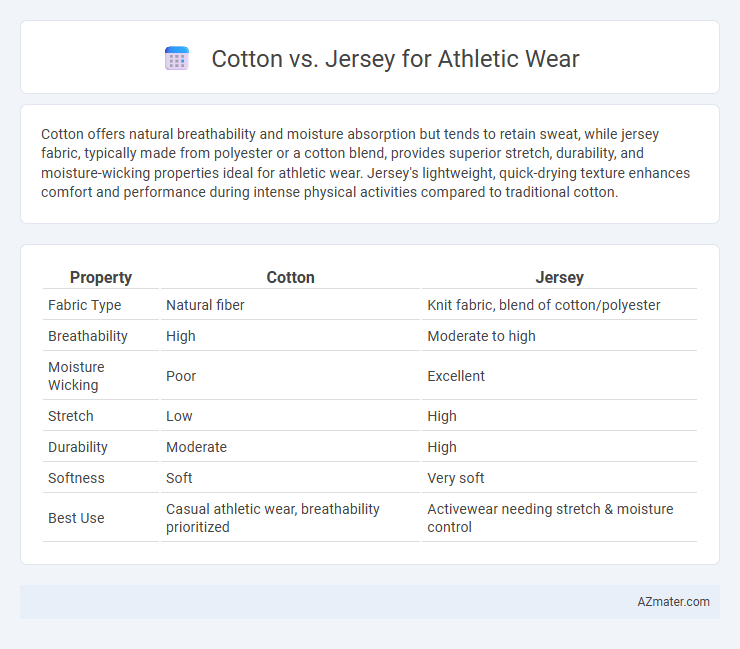Cotton offers natural breathability and moisture absorption but tends to retain sweat, while jersey fabric, typically made from polyester or a cotton blend, provides superior stretch, durability, and moisture-wicking properties ideal for athletic wear. Jersey's lightweight, quick-drying texture enhances comfort and performance during intense physical activities compared to traditional cotton.
Table of Comparison
| Property | Cotton | Jersey |
|---|---|---|
| Fabric Type | Natural fiber | Knit fabric, blend of cotton/polyester |
| Breathability | High | Moderate to high |
| Moisture Wicking | Poor | Excellent |
| Stretch | Low | High |
| Durability | Moderate | High |
| Softness | Soft | Very soft |
| Best Use | Casual athletic wear, breathability prioritized | Activewear needing stretch & moisture control |
Introduction to Cotton and Jersey Fabrics
Cotton fabric, derived from natural cotton fibers, offers breathability, moisture absorption, and softness, making it a popular choice for athletic wear focused on comfort. Jersey fabric, typically a knit textile made from cotton, polyester, or blends, provides superior stretch and flexibility, enhancing movement and fit in activewear. The fundamental differences in fiber composition and knit structure between cotton and jersey influence their performance characteristics in athletic applications.
Fabric Composition and Structure
Cotton athletic wear offers natural breathability and moisture absorption due to its dense, spun fiber composition, making it comfortable but slower to dry. Jersey fabric, often a blend of cotton and synthetic fibers like polyester or spandex, features a knit structure that provides superior stretch, durability, and moisture-wicking properties essential for high-performance sportswear. The looped knit of jersey enhances flexibility and airflow, while cotton's fiber makeup prioritizes softness and insulation.
Moisture Wicking Capabilities
Jersey fabric, often made from synthetic fibers or blends, excels in moisture-wicking capabilities by efficiently drawing sweat away from the skin to the garment's surface for quick evaporation. Cotton, while breathable and soft, tends to absorb moisture and retain sweat, leading to a heavier, damp feeling during intense athletic activities. Athletes seeking maximum comfort and dryness typically prefer jersey materials for their superior performance in moisture management.
Breathability and Comfort
Jersey fabric offers superior breathability compared to cotton, as its knit structure allows better air circulation, making it ideal for athletic wear that demands moisture-wicking properties. Cotton, while soft and comfortable against the skin, tends to retain moisture, which can lead to discomfort during intense physical activity. Athletes often prefer jersey due to its lightweight feel and enhanced ventilation, promoting better temperature regulation and sustained comfort during workouts.
Flexibility and Stretch
Jersey fabric offers superior flexibility and stretch compared to traditional cotton, making it ideal for athletic wear that requires a full range of motion. Cotton tends to be less elastic and can restrict movement, while jersey blends often include spandex or elastane fibers, providing enhanced stretch and recovery. This combination of breathability and flexibility in jersey materials supports optimal comfort and performance during physical activities.
Durability and Longevity
Jersey fabric, typically made from synthetic fibers or blends, offers superior durability and longevity compared to traditional cotton, making it ideal for athletic wear subjected to frequent washing and intense physical activity. Cotton tends to wear out faster due to its natural fiber composition, which absorbs moisture and loses shape over time. Jersey's elasticity and resistance to pilling ensure sustained performance and a longer lifespan in high-stress workout conditions.
Weight and Feel of the Fabrics
Cotton fabric offers a heavier weight and a soft, breathable feel, making it comfortable but less ideal for high-intensity athletic wear due to moisture retention. Jersey fabric, typically made from cotton or synthetic blends, is lighter and stretchier, providing enhanced flexibility and better moisture-wicking properties. The lightweight nature and smooth texture of jersey make it preferable for athletic wear focused on performance and comfort during physical activity.
Odor Control and Hygiene
Jersey fabric, typically made from synthetic fibers like polyester or blends, outperforms cotton in odor control for athletic wear by efficiently wicking moisture away from the skin, reducing bacterial growth that causes bad smells. Cotton, while breathable, absorbs sweat and retains moisture, creating an environment conducive to odor-causing bacteria and lessening hygiene during intense workouts. Choosing moisture-wicking jersey materials enhances athletic hygiene and odor management, supporting prolonged freshness and comfort.
Suitability for Different Sports
Cotton offers breathability and comfort, making it ideal for low-impact sports like yoga and casual workouts, but it retains moisture and dries slowly, which can hinder performance in high-intensity activities. Jersey fabric, often made from synthetic fibers or cotton blends, provides superior stretch, moisture-wicking properties, and durability, enhancing comfort and flexibility for dynamic sports such as running, cycling, and team sports. Athletes seeking optimal performance in vigorous training benefit from jersey's ability to manage sweat and maintain shape, while cotton remains a preferred choice for mild physical activities and leisurewear.
Cost and Availability Comparison
Jersey fabric generally costs more than cotton due to its complex knitting process and moisture-wicking technology, making it a preferred choice for high-performance athletic wear. Cotton is widely available and affordable, offering natural breathability but lacking the stretch and quick-drying properties of jersey. For athletes seeking budget-friendly options, cotton provides easy access, while jersey's higher price reflects advanced functionality and durability in sports apparel.

Infographic: Cotton vs Jersey for Athletic Wear
 azmater.com
azmater.com